GSTT1 is upregulated by oxidative stress through p38-MK2 signaling pathway in human granulosa cells: possible association with mitochondrial activity
- PMID: 22207314
- PMCID: PMC3273902
- DOI: 10.18632/aging.100418
GSTT1 is upregulated by oxidative stress through p38-MK2 signaling pathway in human granulosa cells: possible association with mitochondrial activity
Abstract
We previously reported that GSTT1 was upregulated in human granulosa cells during aging and that activation and localization of p38 MAPK was changed in parallel. Although oxidative stress is responsible for these changes, the age-associated expression of GSTT1 regulated by MAPKs and the role of GSTT1 in aged granulosa cells remain unclear. Therefore, we examined the relationship between the expression of GSTT1 and MAPK signaling pathways using human granulosa-like KGN cells stimulated with H(2)O(2) in the presence or absence of various MAPK inhibitors. Interestingly, H(2)O(2)-induced GSTT1 was only inhibited by a p38 inhibitor. An inhibitor of MK2, a downstream regulator of p38, also diminished H(2)O(2)-induced GSTT1 upregulation. Notably, both p38 and MK2 were significantly inactivated in cells carrying an shRNA construct of GSTT1 (∆GSTT1 cells), suggesting that the p38-MK2 pathway is essential for age-associated upregulation of GSTT1. The relevance of GSTT1 in mitochondrial activity was then determined. ∆GSTT1 cells displayed enhanced polarization of mitochondrial membrane potential without increasing the apoptosis, suggesting that the age-associated upregulation of GSTT1 may influence the mitochondrial activity of granulosa cells.
Conflict of interest statement
The authors have no conflict of interest to declare.
Figures
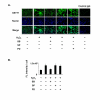
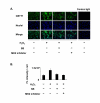
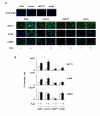
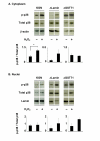
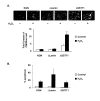
Similar articles
-
Age-associated changes in the subcellular localization of phosphorylated p38 MAPK in human granulosa cells.Mol Hum Reprod. 2010 Dec;16(12):928-37. doi: 10.1093/molehr/gaq076. Epub 2010 Sep 10. Mol Hum Reprod. 2010. PMID: 20833869
-
IL-1β-induced and p38MAPK-dependent activation of the mitogen-activated protein kinase-activated protein kinase 2 (MK2) in hepatocytes: Signal transduction with robust and concentration-independent signal amplification.J Biol Chem. 2017 Apr 14;292(15):6291-6302. doi: 10.1074/jbc.M117.775023. Epub 2017 Feb 21. J Biol Chem. 2017. PMID: 28223354 Free PMC article.
-
Activation of the p38 MAPK pathway by follicle-stimulating hormone regulates steroidogenesis in granulosa cells differentially.J Endocrinol. 2005 Jul;186(1):85-96. doi: 10.1677/joe.1.05955. J Endocrinol. 2005. PMID: 16002539
-
The interplay of p38 MAPK signaling and mitochondrial metabolism, a dynamic target in cancer and pathological contexts.Biochem Pharmacol. 2024 Jul;225:116307. doi: 10.1016/j.bcp.2024.116307. Epub 2024 May 24. Biochem Pharmacol. 2024. PMID: 38797269 Review.
-
Mitogen-activated protein kinase p38 and MK2, MK3 and MK5: ménage à trois or ménage à quatre?Cell Signal. 2010 Aug;22(8):1185-92. doi: 10.1016/j.cellsig.2010.03.002. Epub 2010 Mar 11. Cell Signal. 2010. PMID: 20227494 Review.
Cited by
-
Redox Biology of Human Cumulus Cells: Basic Concepts, Impact on Oocyte Quality, and Potential Clinical Use.Antioxid Redox Signal. 2020 Mar 10;32(8):522-535. doi: 10.1089/ars.2019.7984. Antioxid Redox Signal. 2020. PMID: 31861967 Free PMC article. Review.
-
Exercise improves choroid plexus epithelial cells metabolism to prevent glial cell-associated neurodegeneration.Front Pharmacol. 2022 Sep 16;13:1010785. doi: 10.3389/fphar.2022.1010785. eCollection 2022. Front Pharmacol. 2022. PMID: 36188600 Free PMC article.
-
Cytotoxic activity of the MK2 inhibitor CMPD1 in glioblastoma cells is independent of MK2.Cell Death Discov. 2015 Sep 7;1:15028. doi: 10.1038/cddiscovery.2015.28. eCollection 2015. Cell Death Discov. 2015. PMID: 27551460 Free PMC article.
-
A Human Pluripotent Stem Cell Model of Facioscapulohumeral Muscular Dystrophy-Affected Skeletal Muscles.Stem Cells Transl Med. 2016 Sep;5(9):1145-61. doi: 10.5966/sctm.2015-0224. Epub 2016 May 23. Stem Cells Transl Med. 2016. PMID: 27217344 Free PMC article.
-
Glutathione S-Transferase Regulates Mitochondrial Populations in Axons through Increased Glutathione Oxidation.Neuron. 2019 Jul 3;103(1):52-65.e6. doi: 10.1016/j.neuron.2019.04.017. Epub 2019 May 14. Neuron. 2019. PMID: 31101394 Free PMC article.
References
-
- Strange RC, Lear JT, Fryer AA. Glutathione S-transferase polymorphisms: influence on susceptibility to cancer. Chem Biol Interact. 1998;111-112:351–364. - PubMed
-
- Saadat I, Saadat M. Influence of genetic polymorphisms of glutathione S-transferase T1 (GSTT1) and M1 (GSTM1) on hematological parameters. Mol Biol Rep. 2010;37:249–253. - PubMed
-
- Ketterer B. A bird's eye view of the glutathione transferase field. Chem Biol Interact. 2001;138:27–42. - PubMed
-
- Cheng JZ, Singhal SS, Sharma A, Saini M, Yang Y, Awasthi S, et al. Transfection of mGSTA4 in HL-60 cells protects against 4-hydroxynonenal-induced apoptosis by inhibiting JNK-mediated signaling. Arch Biochem Biophys. 2001;392:197–207. - PubMed
Publication types
MeSH terms
Substances
LinkOut - more resources
Full Text Sources
Other Literature Sources

